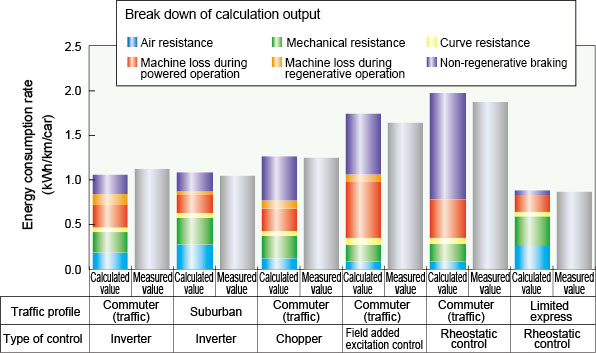1.Simple method for calculating the energy consumption rate of railway vehicles
- A method was designed to allow simple calculation of an electric or diesel rail vehicle’s energy consumption rate without complex running simulations.
- Comparisons with measured data demonstrated that the error margin of this method is below 10%; energy consumption rate data obtained with this approach can also be broken down into individual components.
It is essential for railways experts developing low energy strategies to be able to estimate appropriately the energy saving effectiveness of newly introduced rolling stock. A new method for calculating energy consumption was therefore developed in order to avoid highly complex running simulations involving massive data input and complicated running data.
The developed method only requires a dozen or so fundamental data items such as vehicle mass, machine efficiency, average distance between stations, average speed, inter alia, which are then used to calculate energy losses due to running resistance, machine losses and other losses. Then the summation of these losses gives overall energy consumption rates.
The overall energy consumption rate can then be broken down, signifying that this method is also a means to design even more efficient energy saving measures.
The calculation method in question relies on simple running profiles. Consequently error margins may increase slightly in the case of more complex running profiles associated with express trains for example, such as sharp curves or speed restrictions for passing through stations without stopping, whereas in the case of commuter train type traffic, results are expected to be relatively more precise.
Comparison of output from the method with measured data from a variety of different vehicles and running profiles showed that the error margin was below 10%, validating the simple calculation method’s sufficient level of accuracy (Fig.10).
The calculation method has been posted on the RTRI website as a running web application, and is open to all to be used. The calculation programme can be customized to individual user requirements.

Fig.1 Comparison of measured data and calculated output applying the method
to a variety of different types of electrical rail car and running profiles.